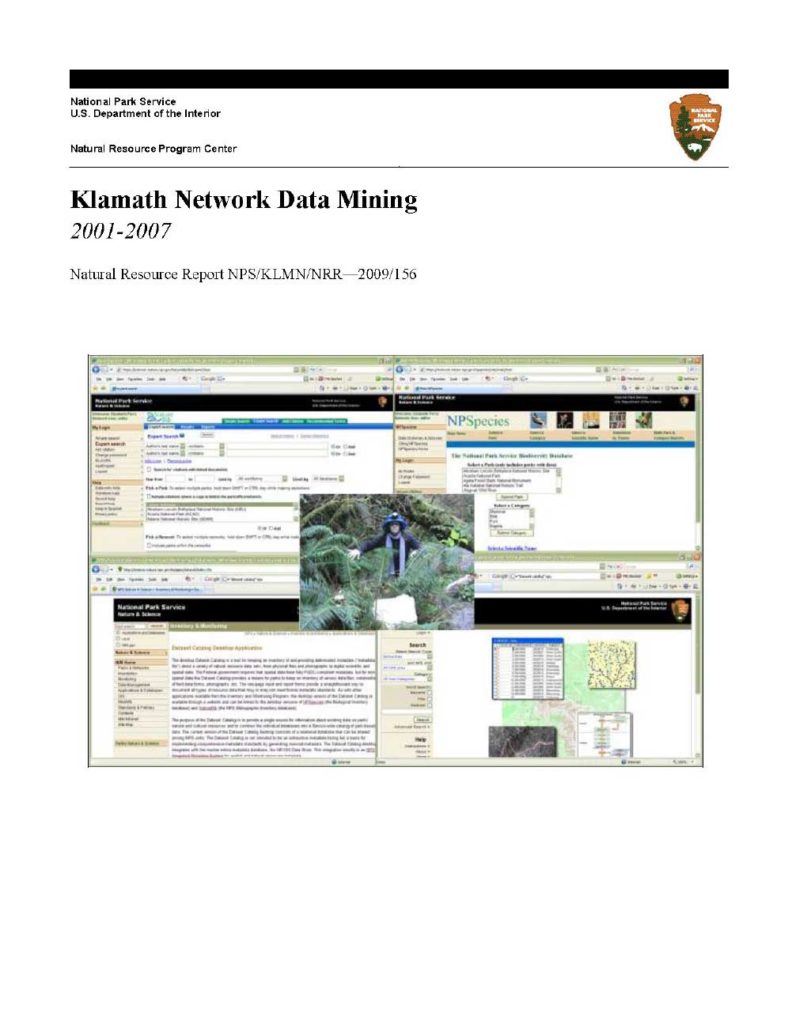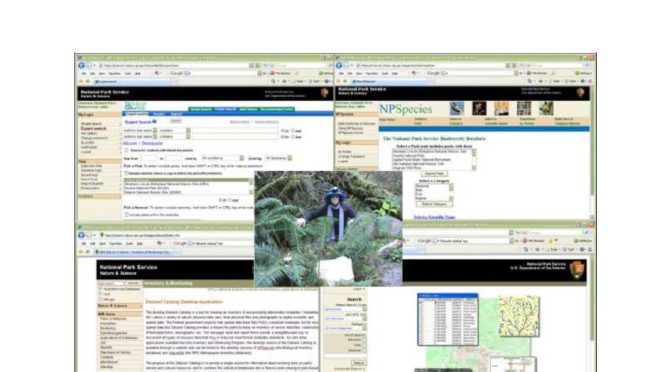
The KLMN Data Mining Team (DMT) sought out information tucked away in filing cabinets, boxed up in storage, written as digital files, and kept at outside institutions. The focus of gathering the information was centered around the 12 Basic Inventories, which is a set of core natural resource inventory data needed to effectively manage a park‘s resources (developed by the I&M Program). This set of 12 distinct categories, first identified in Appendix A of the Natural Resource Inventory and Monitoring Guidelines (NPS 1992), and additionally supported through NPS Inventory and Monitoring web sites (NPS 2003), includes the following abiotic and biotic ecosystem components:
1) Natural Resource Bibliographies
2) Comprehensive Vascular and Vertebrate Species List
3) Species Occurrence and Distribution
4) Vegetation Inventory
5) Base Cartography Data
6) Soils Resources Inventory
7) Geology Resources Inventory
8) Water Bodies Location and Classification
9) Baseline Water Quality Data
10) Air Quality Data
PDF download, 49 pages:
Klamath Network Data Mining 2001-2007 pub 2009
Other pages in this section
- CL Natural Resource Preservation and Research Fact Sheet 2000
- Overview of Limnology at Crater Lake Larson 1996
- Breeding Data on Crater Lake Fish – 1933
- Bull Trout Population Edwin Pister 1992
- Bull Trout Restoration and Brook Eradication – Buktenica 1994
- Distribution Bull Trout – Larson – 1995
- Fisheries Investigations in Crater Lake, Oregon, 1937-1940 by Arthur D. Hasler and D. S. Farner
- George Ruhle to Wallis Fish Planting 1951
- Post-Eruptive History and Bathymetry 2002
- Composition of the Water of Crater Lake, by Walton Van Winkle and N. M. Finkbiner, 1913
- Horizontal Distribution and Vertical Migrations of Zooplankton – Owen Hoffman 1969
- Ultraviolet Radiation and Bio-optics in Crater Lake, Oregon, Hargreaves, Girdner, Buktenica, Urbach and Larson, 2005
- The Impact of Climate on the Physics, Hydrology, and Biogeochemistry of Crater Lake, Oregon, July 1999 – June 2004
- Temperature Microstructure in Crater Lake, by Neal, Neshyba, Denner, Limnology and Oceanography, Vol. 16, No. 4 July, 1971
- Representative Freshwater Bacterioplankton Isolated from Crater Lake, Paige, Connon, Giovannoni, 2004
- Ecosystem Analysis Using Modeling, D’Ambrosio, Alterdorf, Jorgensen
- Vertical Temperature Structure in Crater Lake, Oregon (PDF file) by Neal, Neshyba, Denner, Limnology and Oceanography, Vol. 17, No. 3 May, 1972
- Mixing Dynamics in Crater Lake, Crawford, with contributions from Collier, Larson and others 2003
- Whitehorse Pond Limnological and Vascular Plant Study, 1993
- Detecting Long-Term Hydrological Patterns, Peterson, Silsbee, Redmond, Northwest Science, Vol. 73, No. 2, 1999
- Cruise Report, R/V Surf Surveyor Cruise, Mapping the Bathymetry of Crater Lake, Oregon, Gardner, USGS, 2000
- Hydrologic Benchmark Network Stations in the Western U.S. 1963-95, USGS
- Hydrology of Crater, East and Davis Lakes – Phillips 1968
- Horizontal Distribution and Vertical Migrations of Limnetic Zooplankton in Crater Lake, Hoffman 1969
- Crater Lake Drifter Test – Preliminary Data Report, 1997
- Crater Lake Limnological Studies Final Report, Larson, McIntire, Jacobs 1993
- Chemical Analyses of Waters from Crater Lake and Nearby Springs, Thompson, White, Nathenson, 1987
- Water balance for Crater Lake, Oregon by Manuel Nathenson, 1991?
- Klamath Network Water Quality Report (Phase II). Hoffman, Currens and Madej., 2005
- Klamath Network Amphibians and Reptiles Survey 2005
- Temperatures of Springs in the vicinity of Crater Lake, Nathenson, 1990
- Report on the Presence or Absence of Significant Thermal Features Within Crater Lake, 1992
- Hydrothermal Processes in Crater Lake, Oregon – extracted from OSU College of Oceanography Report #90-7, 1991
- Hydrothermal Processes in Crater Lake – Collier 1987
- Interpreting Variations in Secchi Disk Transparencies – Larson – 1980
- First Annual Limnological Report – 1983
- Geochemistry and Phytoplankton Studies – Collier – 1987
*** previous title *** --- *** next title ***



